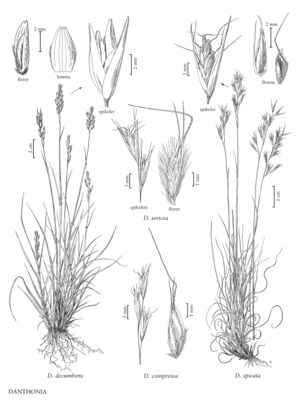Danthonia decumbens
Culms 8-60 cm, usually erect, sometimes decumbent, not disarticulating. Sheaths glabrous or pilose; blades 5-15 cm long, 0.5-4 mm wide, usually flat, glabrous or sparsely pilose. Inflorescences with up to 15 spikelets; branches erect; lower branches with 1-3 spikelets. Spikelets 6-15 mm; florets usually cleistogamous, rarely chasmogamous. Calluses of middle florets from as long as to a little longer than wide, convex abaxially; lemma bodies 5-6 mm, margins glabrous or pubescent for most of their length, scabrous apically, apices with acute teeth, teeth often scabrous, sometimes scabridulous, mucronate, not awned, from between the teeth; palea veins swollen at the base, forming pulvini; anthers of the cleistogamous florets 0.2-0.4 mm, those of the chasmogamous florets about 2 mm. Caryopses 2.1-2.5 mm long, 1.1-1.8 mm wide. 2n = 24, 36, 124.
Distribution
B.C., Nfld. and Labr. (Labr.), N.S., Calif., Oreg., Wash.
Discussion
Danthonia decumbens grows throughout most of Europe, the Caucasus, and northern Turkey, and is now established on the west and east coasts of North America. It grows in heathlands, sandy or rocky meadows, clearings, and sometimes along roadsides. The species is sometimes placed in the monotypic genus Sieglingia, as Sieglingia decumbens (L.) Bernh.
Selected References
None.
